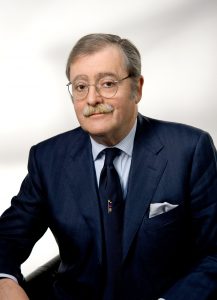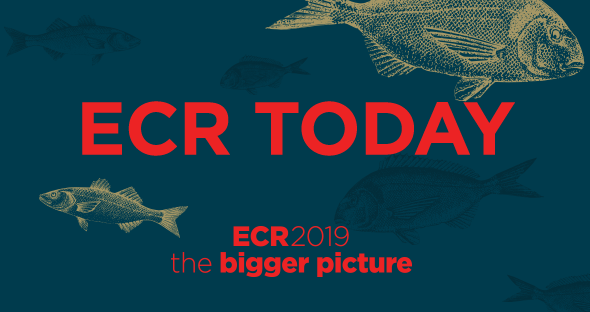Welcome to ECR 2019!
Welcome to the 25th ECR in Vienna!
Thanks for coming to be a part of ‘the bigger picture’!
By Lorenzo E. Derchi, ESR President
ECR 2019 marks an important anniversary. This will be the 25th ECR congress held in Vienna since 1991: a great achievement! Those who have been coming here since the beginning will find a meeting that has become bigger over the years, now including not only the Austria Center, but also many of the buildings surrounding it.
It is a true ‘congress city’, which has grown to accommodate the increasing numbers of delegates from all over the world. Those who are here for the first time will discover a congress with a wide range of opportunities to learn about the different aspects of our specialty, with sessions suited to all, from beginners to advanced professionals.

ESR President Prof. Lorenzo E. Derchi is Head of the Department of Radiology at the University of Genoa, Italy.
Over the years, the ECR has provided radiologists with a European platform for the presentation of research and debate and has been the key to the creation of a community of people working together and advancing in science and education together. This has been the result of the efforts of 24 Congress Presidents and Programme Planning Committees who, with the help of the well-structured and dedicated efforts of the ESR Scientific Programme Department, have worked as in a relay team, passing the baton from one to the next and ensuring continuity of aims and good results over the years.
The ECR has always been a creative meeting. It started with a ‘classical’ structure, made up of refresher courses, scientific presentations and posters, and, over the years, has incorporated various new ways for contributors to present scientific work. The first big innovation was in 2003, with the introduction of the electronic posters of EPOS. Then, in 2016, came the new session format ‘the Voice of Epos’ in which the scientific message of selected posters could be explained in person by their authors. Last year, the ‘MyT3’ presentations, the lounge meetings of ‘Coffee & Talk’ and the hands-on approach to interventional radiology of ‘the Cube’ were introduced. All these session formats have proven successful and will be continued, and even expanded, this year. Furthermore, an additional new session type will be launched, not only for ECR delegates, but also open to anyone who is interested in joining in. The ‘Women in Focus’ initiative will explore the challenges encountered by women in our field and in other medical and medical-related professions. It will open a debate over gender parity in our profession and will try to present role models to whom the ever-increasing number of women entering into radiology can relate.
The 25th ECR in Vienna can be considered as a chance to reflect on the journey of European radiology through the past years and as a starting point for the future. This is why it has been called ‘the bigger picture’. The concept is reflected in the educational programme, in which basic sessions for students and a state-of-the-art programme for residents and young radiologists sit side-by-side with discussions on the future of our discipline. The impact of artificial intelligence on our work, the new diagnostic horizons provided by liquid biopsy, the need to increase the visibility of radiology and to develop respectful and fruitful relationships with patients in everyday clinical practice, and the challenges that medical doctors have to meet in dealing with humanitarian emergencies, are only a few of the important topics we will discuss.
The willingness of the radiological community to play an active part in ‘the bigger picture’ has been demonstrated by the record number of high-quality abstracts we received. I have to deeply thank the many colleagues who have submitted the results of their studies for consideration at the meeting. We have tried to increase the number of scientific sessions in order to accommodate the majority of them and give the chance of active participation to as many as possible.
A high number of abstracts has been received from the ‘ESR meets’ countries. These will be Italy, my home country, Pakistan, and the whole African continent. The ‘ESR meets’ initiative provides the chance to get to know our colleagues from these places better and, when meeting radiologic societies from other continents, to learn how these colleagues work and live, to strengthen relationships and to create friendships with them. This year, for the first time, we will meet many radiologists from Africa. We will try to understand what the European Society of Radiology can do for them and, at the same time, what we can learn from their experience.
Three well-known leaders in different fields of radiology will hold this year’s Honorary Lectures. Prof. Paul S. Sidhu’s lecture is titled ‘Contrast-enhanced US in paediatrics: ready for clinical practice?’ and will address a technique that is not widely used and whose benefits are not yet fully explored. Prof. Regina Beets-Tan will discuss the new frontiers of oncologic imaging in her lecture ‘Oncologic imaging: a new beginning has just begun’. Finally, Prof. S. Nahum Goldberg will explore the extent of the potentially beneficial and harmful systemic effects of ‘focal’ interventional oncologic radiology by asking the question ‘Systemic effects of image-guided tumour therapy: have we opened Pandora’s Box or found the Holy Grail?’
The European Congress of Radiology will see not only radiologists taking part, but also delegates working in all allied sciences. There will be a number of educational and scientific sessions specifically dedicated to radiographers. The European Federation of Radiographer Societies (EFRS) has made the ECR its flagship meeting and this year there has been a larger number of abstracts submitted by radiographers than ever before. Once again, the ESR/EFRS Joint Radiographer Abstract Awards will be presented to the submitters of the best radiographer abstracts.
If you cannot come to Vienna (someone has to remain home and do the tough work), you can watch ECR Online! Almost all sessions will be broadcast live for you to watch from home. Furthermore, they will be recorded and made available to watch on demand later (often as soon as the same evening). You can even use ECR Online here in Vienna, to watch presentations you were not able to attend. There will be ample lounges where you can get some rest and take the opportunity to see those sessions you could not quite squeeze into your schedule.
Above all, everyone will take the opportunity to discuss, ask questions at the end of the presentations, talk with other colleagues, liaise, and socialise. The annual ECR is THE place where the European community of all radiology professionals meets. We all come here to increase our knowledge; to compare our science and way of practice with colleagues of other nations; to grow and learn how to provide a better service to our patients. We can find here an international horizon for our research through the creation of links among people and institutions that are not only professional but have become, for many, personal bonds of respect and friendship. Over the 24 ECRs held in the past years, we have contributed to creating a community of radiologists advancing together in science and care. We have all worked to achieve the harmonisation of radiological teaching, practice and research in Europe. There is still a lot to do. May ‘the bigger picture’ of this 25th congress in Vienna be the starting point for further unity.



What is that about?